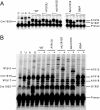Mutations in conserved helix 69 of 23S rRNA of Thermus thermophilus that affect capreomycin resistance but not posttranscriptional modifications
- PMID: 18805973
- PMCID: PMC2583624
- DOI: 10.1128/JB.00984-08
Mutations in conserved helix 69 of 23S rRNA of Thermus thermophilus that affect capreomycin resistance but not posttranscriptional modifications
Abstract
Translocation during the elongation phase of protein synthesis involves the relative movement of the 30S and 50S ribosomal subunits. This movement is the target of tuberactinomycin antibiotics. Here, we describe the isolation and characterization of mutants of Thermus thermophilus selected for resistance to the tuberactinomycin antibiotic capreomycin. Two base substitutions, A1913U and mU1915G, and a single base deletion, DeltamU1915, were identified in helix 69 of 23S rRNA, a structural element that forms part of an interribosomal subunit bridge with the decoding center of 16S rRNA, the site of previously reported capreomycin resistance base substitutions. Capreomycin resistance in other bacteria has been shown to result from inactivation of the TlyA methyltransferase which 2'-O methylates C1920 of 23S rRNA. Inactivation of the tlyA gene in T. thermophilus does not affect its sensitivity to capreomycin. Finally, none of the mutations in helix 69 interferes with methylation at C1920 or with pseudouridylation at positions 1911 and 1917. We conclude that the resistance phenotype is a consequence of structural changes introduced by the mutations.
Figures




Similar articles
-
Capreomycin susceptibility is increased by TlyA-directed 2'-O-methylation on both ribosomal subunits.Mol Microbiol. 2012 Sep;85(6):1194-203. doi: 10.1111/j.1365-2958.2012.08168.x. Epub 2012 Aug 1. Mol Microbiol. 2012. PMID: 22779429 Free PMC article.
-
Capreomycin binds across the ribosomal subunit interface using tlyA-encoded 2'-O-methylations in 16S and 23S rRNAs.Mol Cell. 2006 Jul 21;23(2):173-82. doi: 10.1016/j.molcel.2006.05.044. Mol Cell. 2006. PMID: 16857584
-
A mutation in the decoding center of Thermus thermophilus 16S rRNA suggests a novel mechanism of streptomycin resistance.J Bacteriol. 2005 Mar;187(6):2200-2. doi: 10.1128/JB.187.6.2200-2202.2005. J Bacteriol. 2005. PMID: 15743969 Free PMC article.
-
Distant ribose 2'-O-methylation of 23S rRNA helix 69 pre-orders the capreomycin drug binding pocket at the ribosome subunit interface.Nucleic Acids Res. 2025 Jul 8;53(13):gkaf618. doi: 10.1093/nar/gkaf618. Nucleic Acids Res. 2025. PMID: 40626557 Free PMC article.
-
Tuberactinomycin antibiotics: Biosynthesis, anti-mycobacterial action, and mechanisms of resistance.Front Microbiol. 2022 Aug 11;13:961921. doi: 10.3389/fmicb.2022.961921. eCollection 2022. Front Microbiol. 2022. PMID: 36033858 Free PMC article. Review.
Cited by
-
Increased bacterial hemolytic activity is conferred by expression of TlyA methyltransferase but not by its 2'-O-methylation of the ribosome.Curr Microbiol. 2013 Jul;67(1):61-8. doi: 10.1007/s00284-013-0332-7. Epub 2013 Feb 16. Curr Microbiol. 2013. PMID: 23417025
-
Capreomycin susceptibility is increased by TlyA-directed 2'-O-methylation on both ribosomal subunits.Mol Microbiol. 2012 Sep;85(6):1194-203. doi: 10.1111/j.1365-2958.2012.08168.x. Epub 2012 Aug 1. Mol Microbiol. 2012. PMID: 22779429 Free PMC article.
-
Cryo-electron microscopy structure of the 70S ribosome from Enterococcus faecalis.Sci Rep. 2020 Oct 1;10(1):16301. doi: 10.1038/s41598-020-73199-6. Sci Rep. 2020. PMID: 33004869 Free PMC article.
-
Comparison of solution conformations and stabilities of modified helix 69 rRNA analogs from bacteria and human.Biopolymers. 2012 Feb;97(2):94-106. doi: 10.1002/bip.21706. Epub 2011 Aug 19. Biopolymers. 2012. PMID: 21858779 Free PMC article.
-
The development of peptide ligands that target helix 69 rRNA of bacterial ribosomes.Bioorg Med Chem. 2016 Sep 15;24(18):4486-4491. doi: 10.1016/j.bmc.2016.07.050. Epub 2016 Jul 25. Bioorg Med Chem. 2016. PMID: 27492196 Free PMC article.
References
-
- Ali, I. K., L. Lancaster, J. Feinberg, S. Joseph, and H. F. Noller. 2006. Deletion of a conserved, central ribosomal intersubunit RNA bridge. Mol. Cell 23865-874. - PubMed
-
- Cameron, D. M., J. Thompson, P. E. March, and A. E. Dahlberg. 2002. Initiation factor IF2, thiostrepton and micrococcin prevent the binding of elongation factor G to the Escherichia coli ribosome. J. Mol. Biol. 31927-35. - PubMed
-
- Dallas, A., and H. F. Noller. 2001. Interaction of translation initiation factor 3 with the 30S ribosomal subunit. Mol. Cell 8855-864. - PubMed
Publication types
MeSH terms
Substances
Grants and funding
LinkOut - more resources
Full Text Sources
Medical
Molecular Biology Databases

